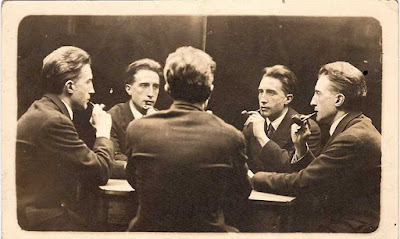 |
| Five Way Portrait of Marcel Duchamp (click to enlarge) |
"Cubism -- highly influential visual arts style of the 20th century that was created principally by the painters Pablo Picasso and Georges Braque in Paris between 1907 and 1914. The Cubist style emphasized the flat, two-dimensional surface of the picture plane, rejecting the traditional techniques of perspective, foreshortening, modeling, and chiaroscuro and refuting time-honoured theories of art as the imitation of nature. Cubist painters were not bound to copying form, texture, colour, and space; instead, they presented a new reality in paintings that depicted radically fragmented objects, whose several sides were seen simultaneously." [source]
-------------------------
"With his next major work, Nude Descending a Staircase (1912) he (Marcel Duchamp) began to break from Cubism.
There are some familiar traces of Cubism here. For instance, the painting has a limited color scheme of browns and muted yellow, and the subject (the nude figure) is splintered into abstract, geometric forms. But while most early Cubist works focused on static or even motionless subjects, like still lifes or portraits of seated people, Duchamp's Nude depicts its subject in motion.
The barely-recognizable nude is shown from numerous points of view all at once, frozen in time. It's as if Duchamp was trying to paint thirty paintings at once, one for each step down the stairs. The background of the painting is also more faded than the foreground, making it seem like the nude is walking forward to the viewer." [source]
No comments:
Post a Comment